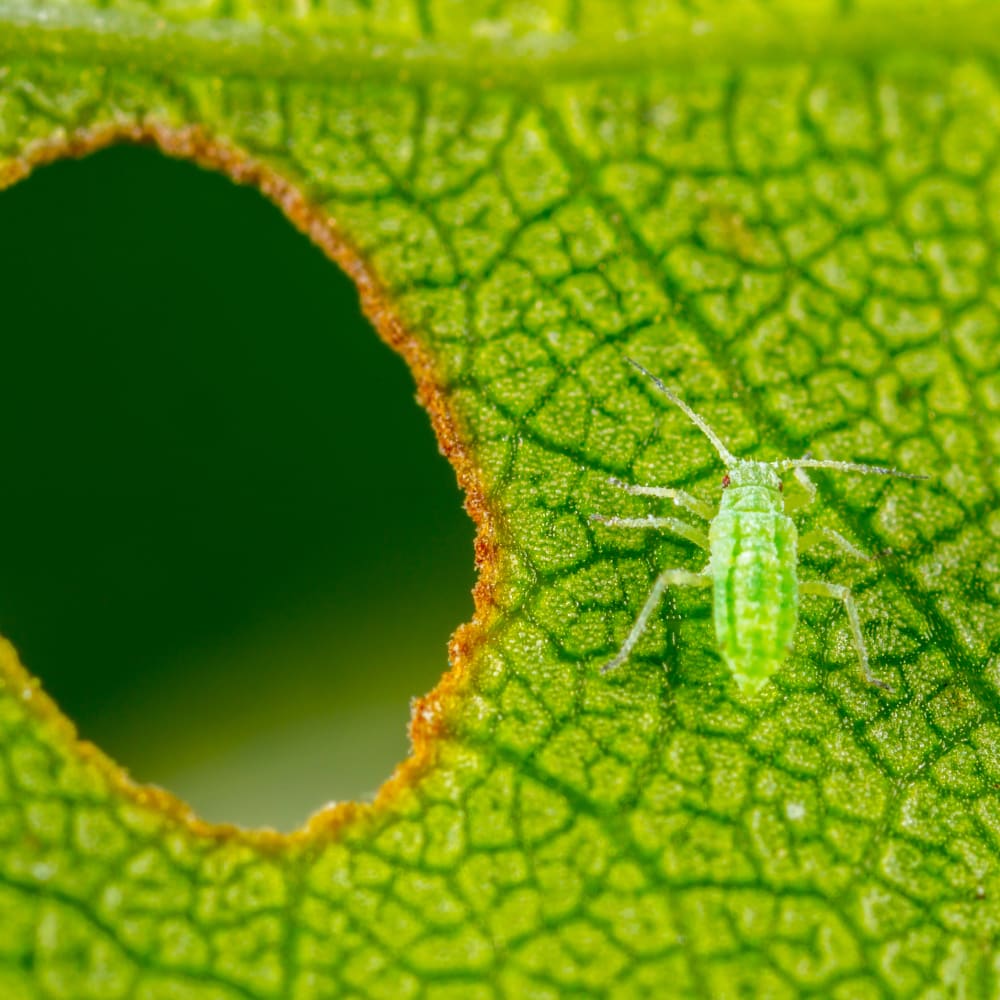
Indoor
How to get rid of bugs
Banish pesky plant pests
Have you noticed uninvited guests on your houseplant? Don’t worry, bugs are not a sign of poor plant care. Sometimes insects just find plants as appealing as we do.
All our plants are thoroughly checked before delivery to ensure they’re bug-free, so you shouldn't see any pests on new plants, but we recommend giving your plants a check-up every three months. The earlier you find the pests, the easier they are to get rid off.
If you do find anything, don't panic. Infestations can usually be fixed. The first thing to do is isolate the affected plant, so the bugs don't spread further. Use the pictures below to identify what sort of bugs you have, as treatment varies. We don’t recommend any harsh artificial chemicals. Now, let’s identify your unwanted critters.

Spider mites
These tiny red arachnids are especially attracted to palms. They hang out on the underside of leaves and devour leaf cells, until your plant’s leaves are riddled with holes. You may notice their very fine webbing before you spot a bug.
The best way to get rid of them is with insecticidal soap, which suffocates them. Start by thoroughly wiping the plant, or giving it a good wash in the shower, to get rid of the webbing (the webbing protects the eggs so you need to clear it to properly fight the infestation). Then mix up your soap in a spray bottle according to the instructions and drench the plant with it. Really drench it. Repeat once a week for three weeks and they should be gone.

White fly
These flies look a bit like very small moths. They’ll suck on your plants, usually causing leaves to yellow and drop off. If you notice them, isolate your plant quickly. White fly will quickly scatter when disturbed and you don’t want to spread them around.
You can wash a lot of them off with a hose or in the shower. They’re also attracted to the colour yellow, so yellow sticky traps will help to dispose of a lot of them. Spraying thoroughly with insecticidal soap will help to kill off any young insects before they grow wings. Repeat once a week for three weeks.

Scale
Scale gets its name because it looks like tiny, usually brown, scales on your plants. The scaly bugs are adults, which live in one spot, sucking out all your plant’s juices. Only the young insects can move. The adults’ hard shells make them one of the tougher bugs to remove. The good news is that they can’t move between plants without direct contact.
Start by scraping off any bugs you can see. Cover your plant’s soil with newspaper or a plastic bag so bugs don’t fall into it. Some may hang on quite tightly, but be persistent. You can use a stiff toothbrush if you don’t want to touch the scale. Once you’ve removed them, spray your plant with insecticidal soap, making sure to spray every crevice. This should take care of the tiny, weaker larvae. Repeat once a week for three weeks.

Mealybugs
If you’ve seen white fluffy spots on your plant, it probably has mealybugs. That fluffy stuff is their nest, which they like to build under leaves or where the leaves meet the stem. Left alone, they will suck the life out of your plant, eventually killing it.
The best way to get rid of them is with insecticidal soap. Start by thoroughly wiping the plant to get rid of the webbing (the webbing protects the eggs so you need to clear it to fight the infestation). Then mix up your soap in a spray bottle according to the instructions and drench the plant with it. Really drench it. Repeat once a week for three weeks.

Aphids
Aphids are very small insects, about 1-6mm long, that are usually wingless. If they have wings it usually means they’re on the lookout for another plant to inhabit. They’re typically found on soft, new growth and buds, but you may also see them on older leaves.
You can remove a lot of aphids with a good jet of water. Using either a hose or hand shower attachment, blast off as many of the aphids as you can (don’t use such a powerful jet that it breaks your plant). Repeat every few days to catch any stragglers. You can also use insecticidal soap to drench the leaves and kill off any hidden bugs. Get into all the nooks and crannies as they like to hide in new leaves. Repeat once a week for three weeks.

Fungus gnats
As pest infestations go, fungus gnats are probably the least problematic. They’re generally found on plants with very wet soil that has grown fungus. As the name suggests, they feed on fungus. The adult gnats lay their eggs in the soil, which hatch into larvae that crawl around the soil until they’re fully grown. They’re unlikely to cause any real harm to your plant, but they are unsightly.
To avoid getting them in the first place, be sure not to overwater your plants (follow the finger test). If you have them, try sprinkling a layer of sand over your plant’s soil. It will make it a lot harder for the gnats to get to the soil and lay their eggs.
